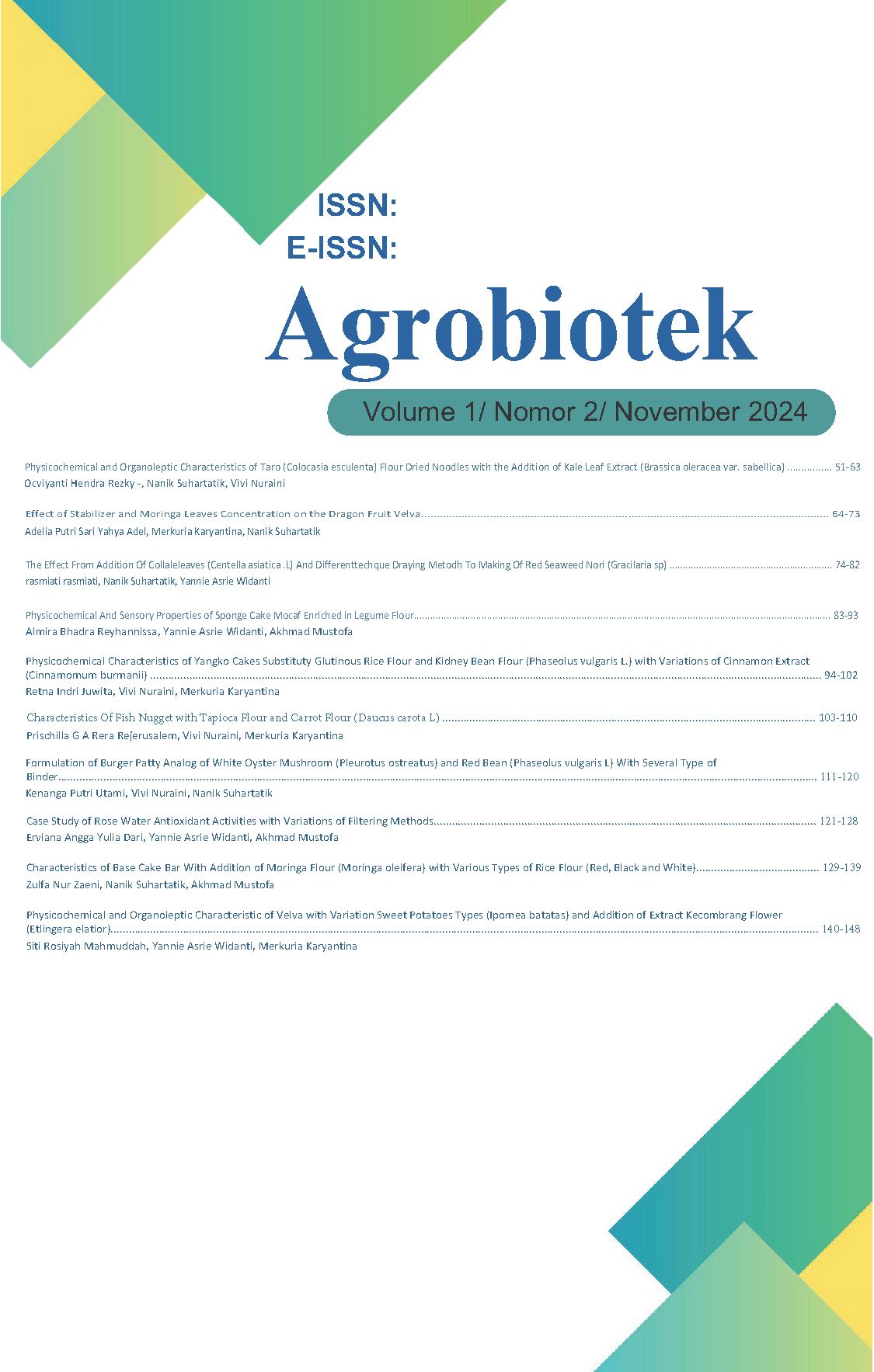Case Study of Rose Water Antioxidant Activities with Variations of Filtering Methods
Studi Kasus Aktivitas Antioksidan Air Mawar Dengan Variasi Metode Penyulingan
DOI:
https://doi.org/10.33061/agrobiotek.v1i2.9823Keywords:
Red rose, rose water, antioxidantAbstract
Red roses (Rosa damascena Mill) are a type of rose with a distinct aroma and a deep red color. Roses are usually used as decoration, but it also has health benefits. Roses have bioactive compounds and anthocyanin pigments that act as antioxidants. The expected outcome of this research is to produce rose water products that have a strong aroma and have high antioxidant activity. This study used a factorial Completely Randomized Block Design (RAKL) method. The factor used is the variation of the distillation method. While the length of the extraction process was used as the sampling time. The correct distillation method to produce rose water which has high antioxidant activity is treatment with variations of the steam distillation method. The steam distillation method obtained the following results: pH 4.07, vitamin C content 40.70 mg/100g, total phenol content 47.10 mg GAE/g, antioxidant activity of DPPH 64.20%, FRAP value 98.97% and sensory test (scent) 3.34.
References
Ameliya, R., & Handito, D. (2018). Pengaruh lama pemanasan terhadap vitamin c, aktivitas antioksidan dan sifat sensoris sirup kersen (Muntingia calabura L.) [The. Pro Food (Jurnal Ilmu Dan Teknologi Pangan),4(1),19.http://www.profood .unram.ac.id/index.php/profood
Amperawati, S., Hastuti, P., Pranoto, Y., Santoso, U., Studi, P., Pengolahan, T., Perkebunan, H., Pertanian, J. T., & Pontianak, N. (2019). Efektifitas frekuensi ekstraksi serta pengaruh suhu dan cahaya terhadap antosianin dan daya antioksidan ekstrak kelopak rosela (Hibiscus sabdariffa L.) Extraction frequency effectiveness and effect of temperature and light on anthocyanin and antioxidant C. Jurnal Aplikasi Teknologi Pangan, 8(1),2019.https://doi.org/10.17728/jatp.3527
Asasia, P. A. A., & Yuwono, S. S. (2018). Pengaruh konsentrasi tepung maizena dan konsentrasi asam sitrat terhadap sifat fisik, kimia dan organoleptik selai mawar. Jurnal Pangan Dan Agroindustri, 6(1), 64–74.https://doi.org/10.21776/ub.jpa.2018.006.01.8
Aulia, L. putri. (2018). Optimasi proses ekstraksi daun sirsak (Annona muricata L) metode MAE (Microwave Assisted Extraction) dengan respon aktivitas antioksidan dan total fenol. Jurnal Agroindustri Halal, 4(1), 079–087. https://doi.org/10.30997/jah.v4i1.1142
Bohari Yusuf, Nur Aini Hayati, dan A. R. (2017). Prosedur Uji Baku. 1–15.
Diana, R. (n.d.). Pemanfaatan Ekstrak Mawar Sebagai Flavour Dan Essence Dalam Pembuatan Es Krim. 230.
Ghasemzadeh, A., & Jaafar, H. Z. E. (2011). Effect of CO 2 enrichment on synthesis of some primary and secondary metabolites in ginger (Zingiber officinale Roscoe). International Journal of Molecular Sciences, 12(2), 1101–1114. https://doi.org/10.3390/ijms12021101
Kartika, B., Hastuti, P., & Supartono, W. (1988). Pedoman uji inderawi bahan pangan. Universitas Gadjah Mada, Yogyakarta.
Marjoni, M. R., Afrinaldi, & Novita, N. A. (2015). Kandungan total fenol dan aktivitas antioksidan ekstrak air daun kersen (Muntingia calabura L.) Total content of fenol and antioxidant activity of the aqueous extract of cherry leaf (Muntingia calabura L.). Jurnal Kedokteran Yarsi, 23(3), 187–196.
Oktavianawati, I., Letisya, N., Citra, P., Utari, D. P., Winata, I. N. A., Handayani, W., & Nugraha, A. S. (2019). Essential oil composition of rose flowers from karangpring village jember district extracted by distillation and enfleurage. Jurnal ILMU DASAR, 20(2), 67. https://doi.org/10.19184/jid.v20i2.8995
Wulandari, Y.W., Nuraini, V., & Rahadhini, M. . (2019). Analisis Kelayakan Usaha Teh Mawar Pada Ukm Didesaclutang-Boyolali. Sustainablecompetitiveadvantage-9(Sca-9), 9(77), 77–84.
Wulandari, Y. W. (2021). AGROINTEK : Jurnal Teknologi Industri Pertanian.
Downloads
Published
How to Cite
Issue
Section
License
Copyright (c) 2024 Erviana Angga Yulia Dari, Yannie Asrie Widanti, Akhmad Mustofa

This work is licensed under a Creative Commons Attribution-ShareAlike 4.0 International License.
Authors who publish with this journal agree to the following terms:
- Copyright on any article is retained by the author(s).
- The author grants the journal, right of first publication with the work simultaneously licensed under a Creative Commons Attribution License that allows others to share the work with an acknowledgment of the work’s authorship and initial publication in this journal.
- Authors are able to enter into separate, additional contractual arrangements for the non-exclusive distribution of the journal’s published version of the work (e.g., post it to an institutional repository or publish it in a book), with an acknowledgment of its initial publication in this journal.
- Authors are permitted and encouraged to post their work online (e.g., in institutional repositories or on their website) prior to and during the submission process, as it can lead to productive exchanges, as well as earlier and greater citation of published work.
- The article and any associated published material is distributed under the Creative Commons Attribution-ShareAlike 4.0 International License







